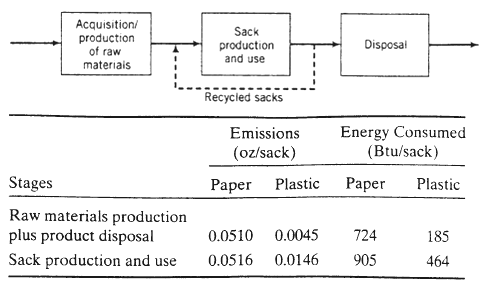A simplified version of the life cycle of grocery sacks is shown below. 4 In the late
Question:
A simplified version of the life cycle of grocery sacks is shown below.4 In the late 1970s, supermarkets began to replace paper sacks with polyethylene (plastic) sacks. In the 1980s, a movement to go back to paper arose, primarily inspired by environmental considerations. In the 1990s, a counter movement arose, claiming that paper sacks have a greater negative environmental impact than plastic ones. As this book goes to press, the debate continues. Following are estimates of the atmospheric emissions and energy consumption associated with the raw materials acquisition and processing (logging, pulping, and paper making for paper, petroleum production and refining and polymerization for polyethylene) and disposal of sacks, and for the manufacture and use of sacks. Assume that atmospheric emissions and energy consumption do not depend on whether the new sacks are made from fresh raw materials or recycled sacks, and that it takes roughly twice as many plastic sacks as paper sacks to hold a given quantity of groceries.
(a) Calculate the air emissions (lbm) and energy consumption (Btu) per 1000 paper sacks used and per 2000 plastic sacks used, assuming that no sacks are recycled.
(b) Repeat the calculations of part (a) assuming that 60% of the used sacks are recycled. By what percentages are air emissions and energy consumption reduced for each sack material as a consequence of recycling?
(c) Estimate the number of grocery sacks used in a day in the United States (population = 300 million), and calculate the average rate of energy consumption (megawatts. MW) associated with the production use, and disposal of these sacks, assuming that they are plastic and none are recycled. How many MW would be saved by 60% recycling?
(d) You should have found that both atmospheric emissions and energy consumption are higher when paper is used rather than plastic, although recycling reduces the differences. Nevertheless, deciding to use plastic based entirely on this result could be a serious mistake. List several important factors that were not taken into account in making the decision including considerations of the potential environmental impact of each type of bag?

Step by Step Answer:

Elementary Principles of Chemical Processes
ISBN: 978-0471720638
3rd Edition
Authors: Richard M. Felder, Ronald W. Rousseau





